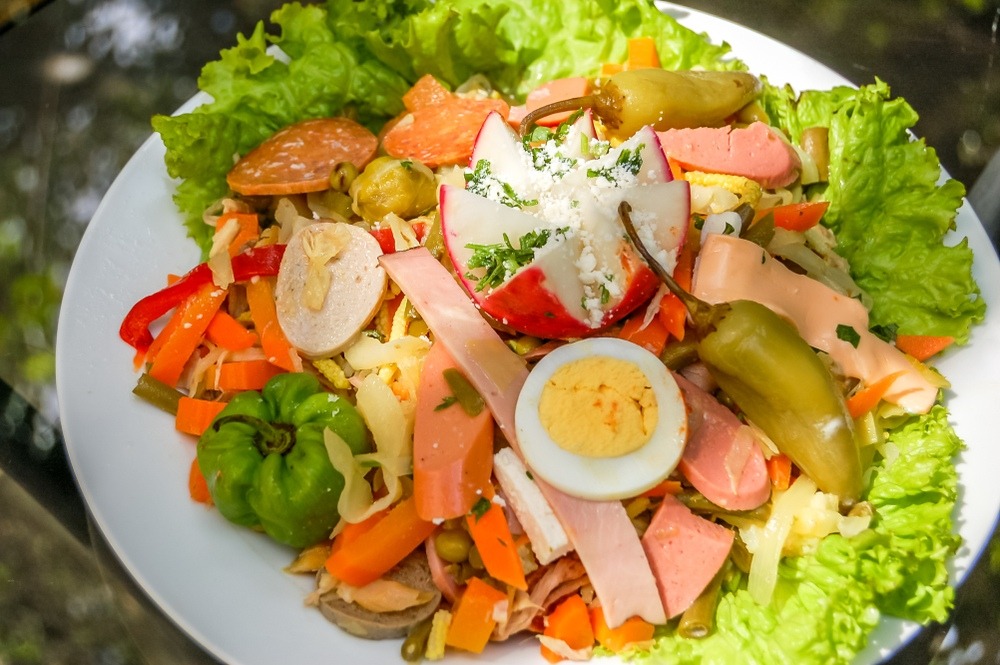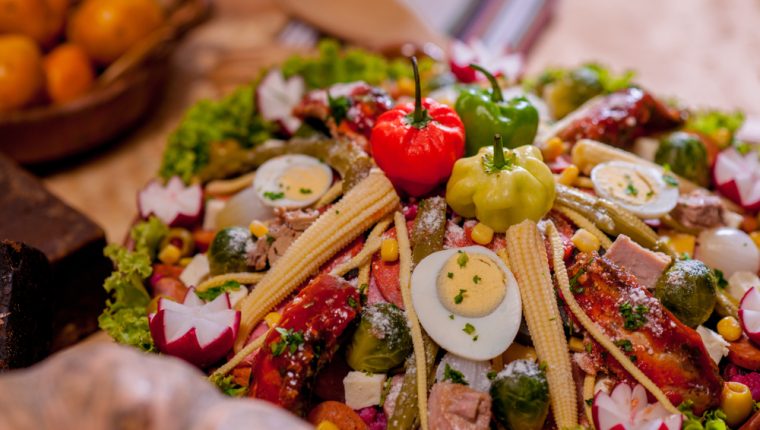In Guatemala, Fiambre holds a special place to the Guatemalan people. It’s basically a a salad that is prepared and eaten by Guatemalan families to celebrate the Day of the Dead (Día de los muertos) which falls on November the 2nd. Traditionally, families visit their loved ones who have passed away at their family mausoleums. Normally, they spend the whole day there and so food, particularly fiambre becomes the centrepiece of the day.
The literal translation from Spanish of Fiambre is cold meat, and although there are various variations here in Guatemala of fiambre, the fiambre from Antigua is the most traditional version.
If you’re visiting Guatemala around the the Day of the Dead, then you’ll find some restaurants serving fiambre. Perhaps the most famous of those restaurants is La Fonda De La Calle Real located here in Antigua.
However, if you have no plans do visit Guatemala, well don’t worry we have a Fiambre recipe that you can prepare in your own house.

INGREDIENTS:
Vegetables:
Large carrots
Tender pacaya
Medium cauliflower
Green beans
Chickpeas
Tender beans
Cabbage
Brussels sprouts
Beetroot (Use as an ingredient if you want “red” fiambre If you want “white” fiambre then do not use it)
Meat and Cheese:
Dried meat
Chicken
Beef
Marrano Post
Chicken
Black Chorizos
Red Chorizos
Sausage
Hams, salami and sausages (in all possible varieties)
Fresh cheese
Layered Cheese
Yellow and white sliced processed cheese
Dry cheese
Garnish:
Chili Peppers (Cut into Strips)
Chamborotes chili peppers
Endive or curly leaf lettuce
Radishes (Cut into little flowers)
Green Olives Stuffed with Chili Pepper
Capers
Chopped parsley)
Asparagus
Baby corn
Pickles
Mushrooms
Sweet corn
Palmetto
Tanned onions
Hard boiled eggs (sliced)
Sardines (Optional)
For the Vinaigrette:
Water
Parsley
Vinegar
Olive oil
Laurel
Ginger
Salt
Mustard
Thyme
Garlic
Onion
A little water from each of the canned goods
Preparation of the fiambre:
Step 1.
Put aside the sweet corn, mushrooms, pickles, baby corn, olives, capers, and pickled onions for garnishing.
Cut the vegetables (carrot, green bean, cabbage) into julienne strips. Then separate the cauliflowers and pacayas from their trunks.
Proceed to cook all the aforementioned vegetables (without overcooking them – just al dente) and as once cooked mix them in a pot or container large enough to hold all the ingredients.
Cook the meats with seasoning to taste.
Step 2.
When all the vegetables are cooked and mixed, reserve half of the sausages, meats and cheeses (all sliced) and some of the ingredients that you saved as garnish. Mix everything well and set it aside in the container while you prepare the caldillo.
For the caldillo, blend a part of each of the vegetable ingredients, using the water, vinegar, salt and pepper. Taking into account that you need to make enough broth to soak the other ingredients in the dish. You must take care of the amount of vinegar you use, as it should not be too acidic.
Add the caldillo to the container in which you already have the vegetables, meats and cheeses. Drop a good amount of olive oil, stir all the ingredients carefully, mixing them, and let it rest overnight. For this, it is preferable that you leave this prepared from October 31 if eating on November 2.
The next day, have large plates ready to place the mixture and you will use the remaining half of the meats and cheeses that you left from the previous day to decorate them. Finish with a slice of hard-boiled egg and radishes cut into a flower shape in the center. Drop dry cheese and chopped parsley on each plate and you are ready to enjoy the traditional fiambre.
Recipe kindly shared by Mrs. Carmen de Molina and her daughter Patricia Molina.
Photos: Prensa Libre



